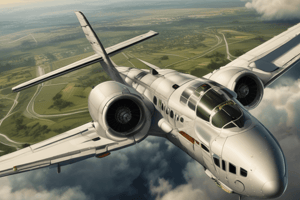Podcast
Questions and Answers
What is the main advantage of using a standard like ARINC 429 for avionics equipment?
What is the main advantage of using a standard like ARINC 429 for avionics equipment?
- It reduces the complexity of data transmission.
- It allows for easier integration of equipment from different manufacturers. (correct)
- It eliminates the need for specialized components for each aircraft.
- It ensures that all data transmission occurs at a high speed.
What is the word size of ARINC 429?
What is the word size of ARINC 429?
- 64 bits
- 32 bits (correct)
- 20 bits
- 16 bits
What is the primary characteristic that differentiates ARINC 429 from the 1553 standard?
What is the primary characteristic that differentiates ARINC 429 from the 1553 standard?
- The bit encoding method
- The number of receivers supported
- The use of a simplex bus (correct)
- The data transmission speed
How many receivers can an ARINC 429 bus support?
How many receivers can an ARINC 429 bus support?
What is the data transmission speed for ARINC 429?
What is the data transmission speed for ARINC 429?
Which of the following bit encoding methods is used in ARINC 429?
Which of the following bit encoding methods is used in ARINC 429?
What is the primary reason for using serial data transmission in aircraft systems?
What is the primary reason for using serial data transmission in aircraft systems?
Which of the following is NOT an example of an older protocol that predates ARINC 429?
Which of the following is NOT an example of an older protocol that predates ARINC 429?
What is the purpose of shielding in the data bus system?
What is the purpose of shielding in the data bus system?
How does ARINC 429 benefit equipment manufacturers?
How does ARINC 429 benefit equipment manufacturers?
What is the purpose of the label field in an ARINC 429 message?
What is the purpose of the label field in an ARINC 429 message?
What is the significance of twisting the wires in the data bus system?
What is the significance of twisting the wires in the data bus system?
What is the primary factor influencing the choice of data transmission speed for ARINC 429?
What is the primary factor influencing the choice of data transmission speed for ARINC 429?
How many receivers can a single wire pair on an ARINC 429 bus support?
How many receivers can a single wire pair on an ARINC 429 bus support?
Which of the following describes the way data travels in a data bus system?
Which of the following describes the way data travels in a data bus system?
What is the main challenge with using multiple different data bus standards in avionics?
What is the main challenge with using multiple different data bus standards in avionics?
What is the typical format of data transmitted on an ARINC 429 bus?
What is the typical format of data transmitted on an ARINC 429 bus?
How many data words are transmitted on the data bus at one time?
How many data words are transmitted on the data bus at one time?
What controls the transmission of data on the data bus?
What controls the transmission of data on the data bus?
What is the function of the Source/Destination Identifier (SDI) in an ARINC 429 message?
What is the function of the Source/Destination Identifier (SDI) in an ARINC 429 message?
Which of the following is NOT a characteristic of ARINC 429 communication?
Which of the following is NOT a characteristic of ARINC 429 communication?
What is the function of the multiplexer bus in the data bus system?
What is the function of the multiplexer bus in the data bus system?
What is the purpose of breakouts (couplers) in the data bus system?
What is the purpose of breakouts (couplers) in the data bus system?
What is the best analogy for the data bus system?
What is the best analogy for the data bus system?
What is the primary concern about data transmission on a free-for-all data bus?
What is the primary concern about data transmission on a free-for-all data bus?
What voltage range represents a binary 1 in a practical system?
What voltage range represents a binary 1 in a practical system?
In the context of data transmission, what is the role of the clock pulse?
In the context of data transmission, what is the role of the clock pulse?
Which of the following is a characteristic of digital data representation?
Which of the following is a characteristic of digital data representation?
How is data transferred in a serial data transfer system?
How is data transferred in a serial data transfer system?
What is a key advantage of serial data transfer over parallel data transfer?
What is a key advantage of serial data transfer over parallel data transfer?
In the given example of serial data transfer, how many bytes of data are being transmitted?
In the given example of serial data transfer, how many bytes of data are being transmitted?
What is the primary function of processing circuitry in the receiver of a serial data transfer system?
What is the primary function of processing circuitry in the receiver of a serial data transfer system?
What was a major challenge faced by aircraft manufacturers as more systems were added to aircraft?
What was a major challenge faced by aircraft manufacturers as more systems were added to aircraft?
What was the primary motivation for sharing information between different aircraft systems in the late 1960s and early 1970s?
What was the primary motivation for sharing information between different aircraft systems in the late 1960s and early 1970s?
What was a major drawback of sharing sensors and signals in analogue aviation systems?
What was a major drawback of sharing sensors and signals in analogue aviation systems?
What was a key issue associated with integrating new functions or systems into existing aircraft?
What was a key issue associated with integrating new functions or systems into existing aircraft?
What was the purpose of Output Multiplier Boxes (OMBs) in analogue aircraft systems?
What was the purpose of Output Multiplier Boxes (OMBs) in analogue aircraft systems?
Which of the following is NOT a characteristic of OMBs?
Which of the following is NOT a characteristic of OMBs?
What did the transition from analogue to digital avionics systems primarily address?
What did the transition from analogue to digital avionics systems primarily address?
What is a key advantage of digital avionics systems compared to analogue systems?
What is a key advantage of digital avionics systems compared to analogue systems?
What did the use of dedicated wiring for analogue signals contribute to?
What did the use of dedicated wiring for analogue signals contribute to?
Flashcards
Binary 0 Voltage Range
Binary 0 Voltage Range
Represents binary 0 with voltages between 0 and 0.8 V.
Binary 1 Voltage Range
Binary 1 Voltage Range
Represents binary 1 with voltages between 2 and 5 V.
Clock Pulse
Clock Pulse
Represents the operating speed of the data bus, synchronizing transmitter and receiver.
Serial Data Transfer
Serial Data Transfer
Signup and view all the flashcards
Parallel Data Transfer
Parallel Data Transfer
Signup and view all the flashcards
Advantages of Serial Transfer
Advantages of Serial Transfer
Signup and view all the flashcards
Digital vs. Analog Voltage
Digital vs. Analog Voltage
Signup and view all the flashcards
ARINC 429
ARINC 429
Signup and view all the flashcards
32-bit word
32-bit word
Signup and view all the flashcards
Label field
Label field
Signup and view all the flashcards
Source/Destination Identifier (SDI)
Source/Destination Identifier (SDI)
Signup and view all the flashcards
Low-speed vs. High-speed bus
Low-speed vs. High-speed bus
Signup and view all the flashcards
Black Boxes
Black Boxes
Signup and view all the flashcards
Purpose of Standardization
Purpose of Standardization
Signup and view all the flashcards
Avionics Technology
Avionics Technology
Signup and view all the flashcards
Integration Challenges
Integration Challenges
Signup and view all the flashcards
Simplex Data Bus
Simplex Data Bus
Signup and view all the flashcards
Bit Encoding in ARINC 429
Bit Encoding in ARINC 429
Signup and view all the flashcards
Output Multiplier Boxes (OMBs)
Output Multiplier Boxes (OMBs)
Signup and view all the flashcards
Analogue Signals
Analogue Signals
Signup and view all the flashcards
Word Size of ARINC 429
Word Size of ARINC 429
Signup and view all the flashcards
Max Receivers in ARINC 429
Max Receivers in ARINC 429
Signup and view all the flashcards
Point-to-Point Wiring
Point-to-Point Wiring
Signup and view all the flashcards
Aircraft Weight and Balance
Aircraft Weight and Balance
Signup and view all the flashcards
ARINC 429 vs 1553
ARINC 429 vs 1553
Signup and view all the flashcards
Complex Wiring Systems
Complex Wiring Systems
Signup and view all the flashcards
Cost Benefits of ARINC 429
Cost Benefits of ARINC 429
Signup and view all the flashcards
Operating Speed of ARINC 429
Operating Speed of ARINC 429
Signup and view all the flashcards
Signal Replication
Signal Replication
Signup and view all the flashcards
Transmitter Requirement
Transmitter Requirement
Signup and view all the flashcards
Serial Transmission
Serial Transmission
Signup and view all the flashcards
Data Bus
Data Bus
Signup and view all the flashcards
Twisted Pair Wires
Twisted Pair Wires
Signup and view all the flashcards
Shielding
Shielding
Signup and view all the flashcards
Simplex Data Transmission
Simplex Data Transmission
Signup and view all the flashcards
Duplex Data Transmission
Duplex Data Transmission
Signup and view all the flashcards
Data Word
Data Word
Signup and view all the flashcards
Bus Controller (BC)
Bus Controller (BC)
Signup and view all the flashcards
Multiplexer Bus
Multiplexer Bus
Signup and view all the flashcards
Breakouts (Couplers)
Breakouts (Couplers)
Signup and view all the flashcards
Study Notes
Data Buses (5.4)
- Data buses in aircraft systems are described
- Data bus communication protocols are described, including MIL-STD 1553, ARINC 429, ARINC 629, Ethernet, and AFDX.
Electric Power
- Electricity is transmitted over heavily constructed power lines from power stations.
- Power lines carry very high voltages and a large electrical current.
- As power is stepped down, the diameter of the wiring decreases to conduct electricity efficiently.
- Different applications require different power amounts.
- Navigation lights and aircraft starter motors both use DC power but require different current levels.
Electrical Data Transmission
- Electricity is an ideal medium for transmitting signals because it travels at the speed of light.
- Data lines ideally have no current flow but can have very small current levels to forward and reverse bias semiconductor P and N junctions.
- Electrical signals are typically small gauge
- Electrical signals transmitted through ICs and data cables (or wireless)
- Information transmitted is in a regulated sequence.
- Computers at either end of the data bus decode and use the data to produce the desired outputs, ranging from displaying location to controlling various mechanisms in an aircraft.
Digital Data Transfer
- Ideal digital signals are square waves.
- Practical digital signals will be distorted due to the nature of transistors.
- In electronic digital systems, binary data is represented by the presence or absence of a voltage.
- Binary 0 is typically represented by 0 V, and binary 1 by 5 V.
- Voltages between 0 V and 0.8 V represent binary 0; between 2 V and 5 V, binary 1.
- Clock signals are used to synchronise data transfer between components
Serial Data Transfer
- Parallel data transfer and serial data transfer are two basic ways to move enormous amounts of data in digital computers.
- In serial transfer, each bit is transmitted sequentially along one line.
- Serial bus is used for long-distance communications and uses less hardware than parallel transfer.
- Serial data transfer is typical of data bus communications
- Multiplexing is used to increase the capacity of serial data buses.
Parallel Data Transfer
- In parallel transfer, each bit is transmitted over its own separate line.
- Parallel data transfer is much faster than serial transfer.
- Parallel transfer requires more hardware requiring more space and weight in aircraft design.
Multiplexing
- Multiplexing combines multiple information channels onto a common transmission medium on aircraft.
- Reduce the number of wires to improve circuit reliability.
- Multiplexing uses time division technique to carry multiple signals on one conductor.
Aircraft Multiplex System
- In the 1950s and 1960s, avionics systems were primarily composed of many separate boxes requiring a complex wiring system.
- The weight and space constraints and the overall complexity of wiring increase as more systems are added.
- The new digital systems were designed to share information among systems through a common digital data bus and have a significant reduction in the weight and wiring complexity.
- New digital technology and the introduction of microprocessors improved computational capability making the systems much more efficient.
Data Bus Systems
- The interface between each computer and external device is accomplished via the digital data bus.
- The bus consists of shielded, twisted wires to eliminate electromagnetic interference.
- Data may travel in one way (simplex) or two directions (duplex), depending on the system design.
Data Bus Connectors
- Multiplexer bus functions like an arterial highway.
- Components are connected to the bus using breakouts and couplers.
- Each computer can have several terminals and can be active at any one time.
Bus Controller
- The bus controller manages all communication on the data bus
- Only one BC is active at any one time
- The BC issues commands controlling data transfer or bus management.
Mil-Std-1553 Data Bus
- Data transmission medium for aircraft communication between systems and subsystems using a single common set of wires
- Time division multiplexing is used.
- Three distinct word types: Command words, Data words, and Status Words
Mil-Std-1773
- Fibre optic cabling is used as a transmission medium in the MIL-STD-1553B bus protocol
- The standard repeats MIL-STD-1553
- The standard does not specify power levels, noise levels, spectral characteristics, optical wavelength, electrical/optical isolation or means of distributing optical power, these will be defined in the specifications of the intended use.
- The standard has differing environmental concerns compared to traditional wire conductors.
Aeronautical Radio Incorporated (ARINC)
- ARINC 429 data bus system is a unidirectional communication protocol
- The system uses a low bit rate (either 12,5 or 100 kb/s)
- The system is used for transmission on separate ports ensuring many separate wires are not needed.
- There are various specifications and standards for avionics equipment, including ARINC 429 and general aviation subset.
ARINC 629
- ARINC 629 is a more recent design for a global data bus within an aircraft, offering faster transfer rates and greater integration capabilities.
- Designed to carry all data between various components.
- Uses a single twisted pair of wires for communication.
- Data is structured to avoid transmission issues.
Studying That Suits You
Use AI to generate personalized quizzes and flashcards to suit your learning preferences.



